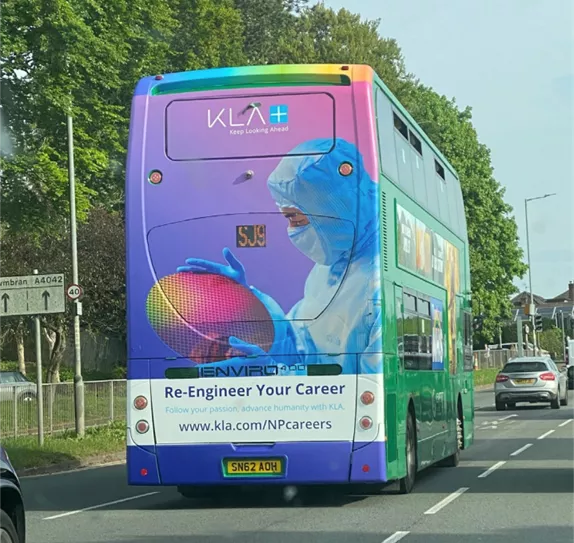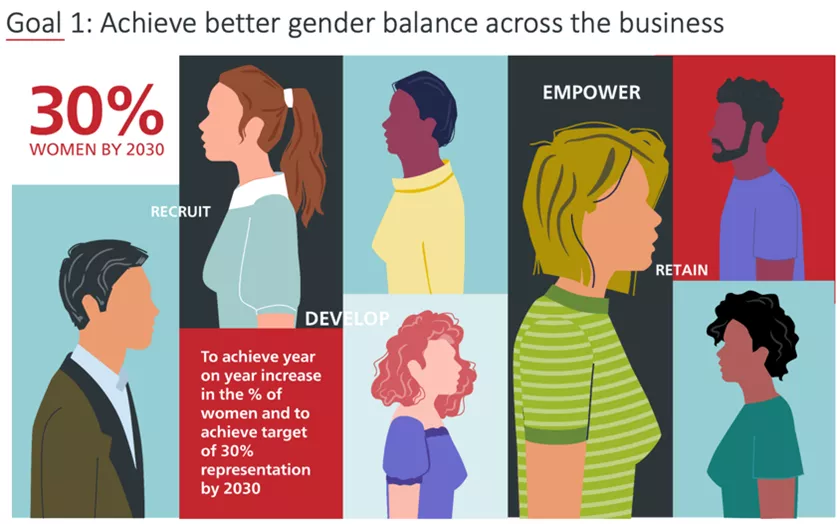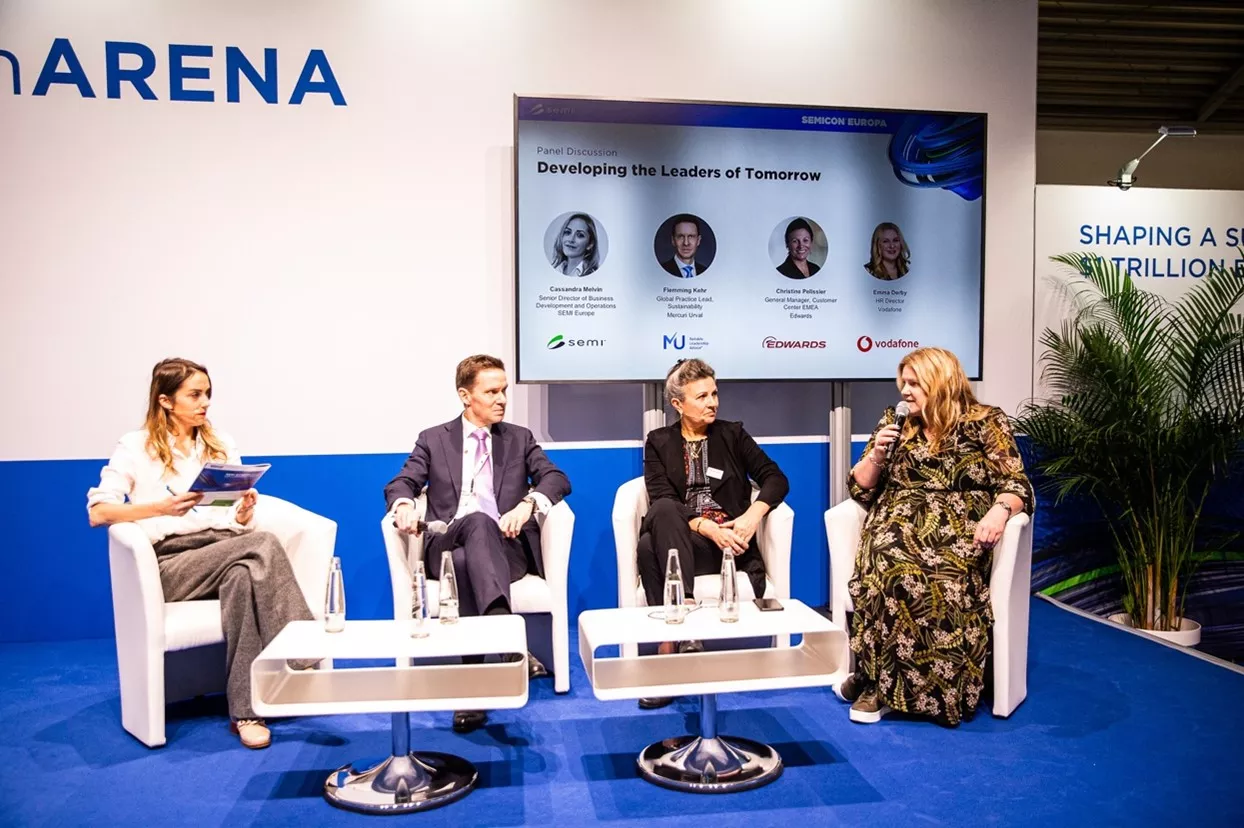A big focus of SEMICON Europa – November 14-16 in Munich – was the quest for talent as exhibition and conferences saw record attendance and exhibitor numbers. And for good reason: Semiconductor industry workforce deficits will soar to an estimated nearly 1 million globally by 2030 as the industry surges toward $1 trillion in economic impact.
Day two of SEMICON Europa featured The Future of Work, an enlightening session that explored the significance of inclusive leadership in fostering a diverse and sustainable workforce. Speakers addressed pressing industry issues such as the global talent shortage, the crucial need to develop the leaders of tomorrow, and strategies the industry can adopt to welcome more diverse talent.
Cassandra Melvin, Senior Director, Business Development and Operations for SEMI Europe, framed the session by discussing the critical talent shortage at a time when the industry is set to grow exponentially. Flemming Kehr, the Global Practice Lead, Sustainability, for Mercuri Urval, joined Melvin for the session titled Cultivating Future-Ready Leadership. Flemming reported that only 7% of companies believe they are building effective global leaders, and that 90% of leadership development programs have limited to no impact on business operations.
The reason for this failure, he posited, was that leadership programs are too generic and do not prepare leaders for specific roles and challenges. Flemming and Cassandra described the new SEMI Leadership Accelerator in partnership with Mercuri Urval, which provides tailored leadership development for companies, and divides programs into three pillars: addressing industry challenges from Board, Executive, and Senior Leadership perspectives.

Dan Collins, General Manager of SPTS Technologies, a KLA company, shared insights during his Challenges and Opportunities Surrounding Your Talent Pipeline session. He described familiar challenges in workforce development: a lack of public awareness of the industry; a lack of diversity in the talent pool; and a lack of relevant and specialized skills. He said the semiconductor industry does not just have an image problem – it extends to simple awareness.
“We need to start presenting our industry in a much bigger, broader way to a much larger audience,” Collins said. “People who live a mile from our factory have no idea a factory is there.”
 He also stressed that flexible working does not just mean working from home. It means being more flexible about how you run your business, and keeping creativity and innovation as core values. KLA builds company awareness in non-traditional spaces, from advertising on buses to sponsoring the local rugby club. He suggests more flexible workplaces, such as crossover or split shifts rather than traditional hours, and special considerations for people with differing needs such as foster parents or women returning to work after having a child.
He also stressed that flexible working does not just mean working from home. It means being more flexible about how you run your business, and keeping creativity and innovation as core values. KLA builds company awareness in non-traditional spaces, from advertising on buses to sponsoring the local rugby club. He suggests more flexible workplaces, such as crossover or split shifts rather than traditional hours, and special considerations for people with differing needs such as foster parents or women returning to work after having a child.
“Start with a blank page and look at your team and figure out what kind of flexible workplace could work for the team you have,” he suggested. “Be creative. Have staff help problem-solve for themselves.”
The final individual session, Sustainability through Inclusion: how Surveys (Insights) + Analysis Support our Understanding of Generational Expectations, featured Christine Pelissier, General Manager of Customer Center EMEA at Edwards. Pelissier reminded the audience that “what gets measured, gets done.” She discussed the need for companies to have ongoing investments in diversity and inclusion (D&I), and business goals related to D&I, such as Edwards’ goal of employing 30% women by 2030.

Edwards uses the Atlas Copco Group Employee Engagement Survey, and typically generates a 75% response rate globally. The survey allows all people in the company to voice their opinions anonymously and safely. They found that employees younger than 25 felt less of a sense of belonging than their older counterparts, and less of a sense of commitment to D&I by the company. Christine coupled this information with data from Monster, which shows that 83% of Gen Z consider an employer’s commitment to DEI before even applying for a job.
“The data we collect doesn’t give us the answers, but it allows us to ask better questions,” she said.
Based on this data, Edwards developed a frame for their plan of action to retain and recruit this generation: “We’ll find out why they aren’t committed to us by committing to them. We need to create a plan that is tailored to this age group.”
The Future of Work’s last session was an engaging panel discussion on Cultivating Future-Ready Leadership, moderated by Melvin and featuring Pelissier, Kehr, and Emma Derby, Human Resources Director at Vodafone. Some of the most compelling topics centered around what current and future leaders need to embrace to be successful. Kehr noted that old-fashioned leaders tend to think they have all the answers. New leaders, he said, “will be facilitators who use the whole organization and teams to generate knowledge, bring ideas to the table, and then make decisions. New leaders will be motivators, not top-down decision makers.” Melvin added that leadership is a “team sport.”

Panel members Cassandra Melvin, Flemming Kehr, Christine Pelissier, and Emma Derby
Derby talked about how inclusion and diversity need to be in the DNA of organizations, and that leaders must not fear leading diverse organizations. “A diverse organization will definitely challenge both the organization and the leadership,” she said. “People with different agendas and backgrounds will by definition challenge the status quo, so resilience and a willingness to receive feedback is critically important in leaders.”
Flemming agreed, pointing out key differences between leaders at hierarchical organizations and those with flatter organizational charts – and it was clear which he thinks have the stronger competitive advantage.
“I think the old model should be dead,” he said. “We are looking at a world with so many complexities and unknowns. If we are bringing in candidates with different approaches and ideas, we need to think about new structures. We need to be more adaptable, and leadership needs to have much more empathy and closer contact with employees.”
Derby discussed the importance of D&I. “It is good for the people we lead and good for our companies to reflect our customer base,” she said. “We all need to feel as though we belong not because there is a metric or KPI but because that is authentically what the workplace engenders.”
Pelissier ended the session with a declaration and a call to action. “We have no choice but to change,” she said. “We have to collaborate, we have to deliver. We need to broaden the talent pool and look beyond our traditional hiring practices, not do what we’ve done in the past.”
Michelle Williams-Vaden is Deputy and Senior Director of Strategy and Partnerships at the SEMI Foundation.